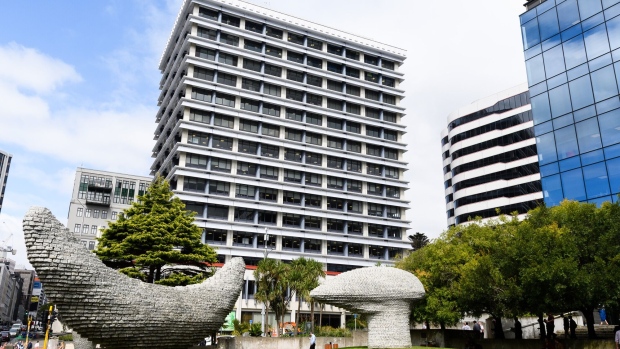Nov 28, 2023
New Zealand Keeps Rates Unchanged, Forecasts Risk of Hike
, Bloomberg News

(Bloomberg) -- New Zealand’s central bank discussed raising interest rates at its final policy meeting of the year and said it will hike them in 2024 if inflation doesn’t decelerate fast enough.
The Reserve Bank’s Monetary Policy Committee held the Official Cash Rate at 5.5% Wednesday in Wellington, as expected by all 23 economists surveyed by Bloomberg. However, the bank surprised economists and investors by raising its forecasts for the OCR — implying a greater chance of an increase — and predicting no reduction until mid-2025.
“We are confident we are restrictive with our monetary policy stance now and that provides us the ability to wait, to watch the data, but certainly highlight our willingness to move if we have to,” Governor Adrian Orr told reporters. “We are showing an upward bias to the interest rate, but it’s not a probability.”
Investors have in recent weeks ramped up bets that central banks globally, including the RBNZ, will pivot to rate cuts in the first half of 2024 as price pressures wane. But Orr said the RBNZ is concerned that inflation has been outside its 1-3% target band for so long, and that record immigration and a housing market recovery are adding to upside risks.
The New Zealand dollar rose half a US cent after the decision, extending today’s gain to 0.9%. It bought 61.88 US cents at 5 p.m. in Wellington.
“The RBNZ statement hammered home the message that interest rates need to remain high for a sustained period, and with some risk a further OCR increase would be needed,” said Nick Tuffley, chief economist at ASB Bank in Auckland. “This message was a shot across the bows of those picking a relatively swift start to the eventual easing cycle.”
The RBNZ’s updated forecasts show the average OCR rising to a peak of 5.69% next year compared to 5.59% in its previous projections. While not fully projecting a 25 basis-point increase, the track implies a reasonably high chance of one. The first rate cut is now envisaged around the second quarter of 2025 rather than in the first.
‘Personal Assault’
Orr said the Monetary Policy Committee is “nervous” that inflation, currently at 5.6%, has been outside its target band since early 2021, and considered raising rates at this meeting.
Core inflation is coming down but not as much as the RBNZ would like and it remains persistent, he said, adding that two-year inflation expectations are not moving rapidly back toward the bank’s 2% goal.
“The 10-year inflation expectation is creeping up away from that midpoint of the target band,” Orr said. “We take that as a personal assault on our credibility and mandate.”
Stephen Toplis, head of research at Bank of New Zealand in Wellington, said the rise in 10-year inflation expectations to 2.28% from 2.22% “hardly seems disastrous to us” and the general trend in expectations has been down.
Still, “it is clear the RBNZ needs to see the whites in the eyes of inflation success before it contemplates easing,” he said. “On this basis we have decided to move our first rate cut back to August 2024 from May 2024.”
What Bloomberg Economics Says:
“The central bank has been spooked by stronger near-term growth that’s being driven by the return of international students and immigrants after the pandemic. But the demand boost from the influx is likely to be more short-lived than the RBNZ is now projecting.”
—James McIntyre, economist
To read the full note, click here
The RBNZ projects that inflation will fall below 3% by the third quarter of 2024, unchanged from the previous forecast. But the economy is now seen avoiding the recession the central bank had predicted.
“While growth in parts of the economy is slowing, there has been less of a decline in aggregate demand growth than expected earlier in the year,” the RBNZ said. Committee members “noted that net immigration has been higher than previously assumed.”
New Zealand is experiencing a record inflow of migrants, adding to risks that inflation will remain sticky. Net immigration rose to 118,835 in the year ended September.
While this has increased the supply of workers into a tight labor market, “the demand-side effects are becoming apparent,” the RBNZ said.
“Strong population growth has contributed to an increase in housing rents,” it said. “Rent increases, and any increases in construction costs in response to greater housing requirements, affect inflation directly.”
--With assistance from Tomoko Sato.
(Updates with Governor’s comments)
©2023 Bloomberg L.P.






